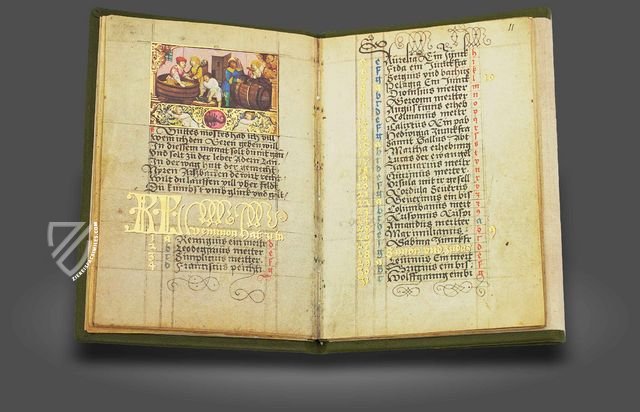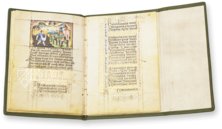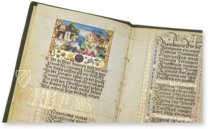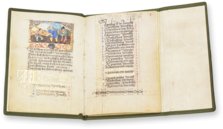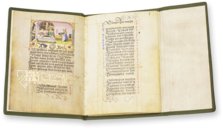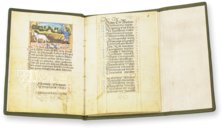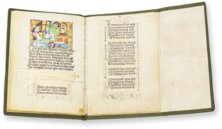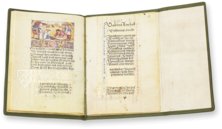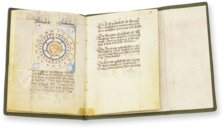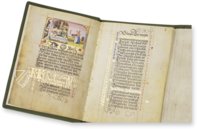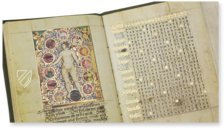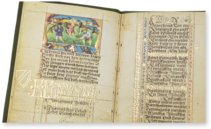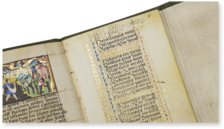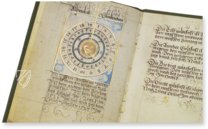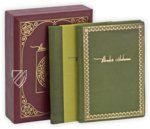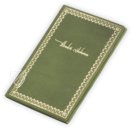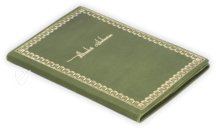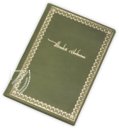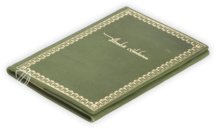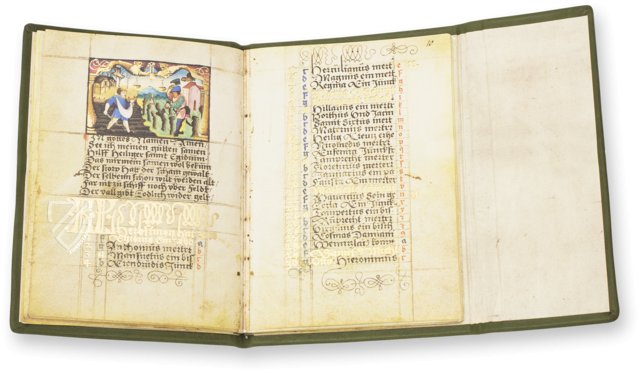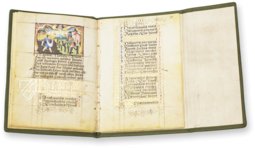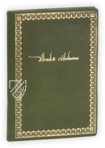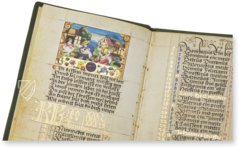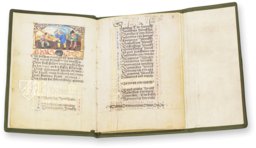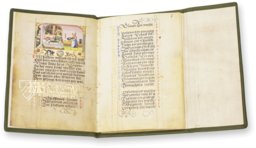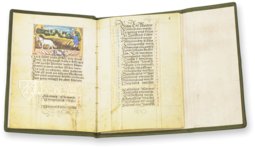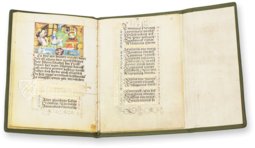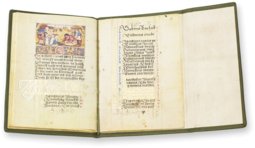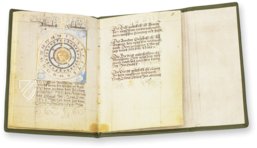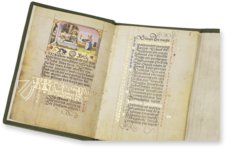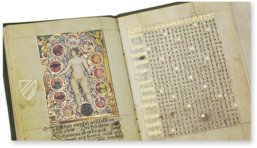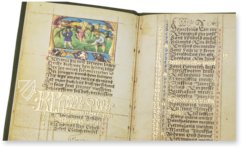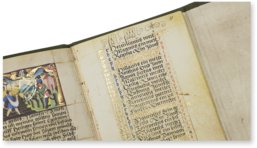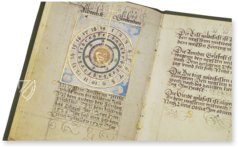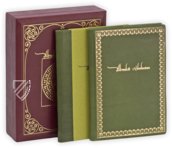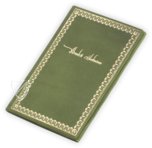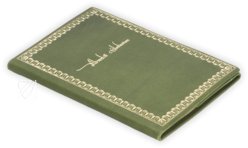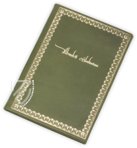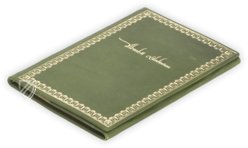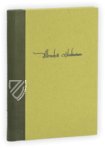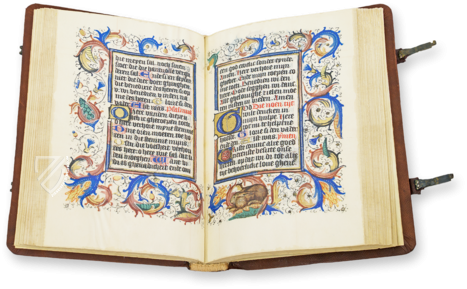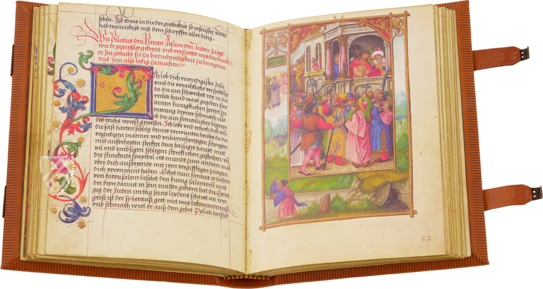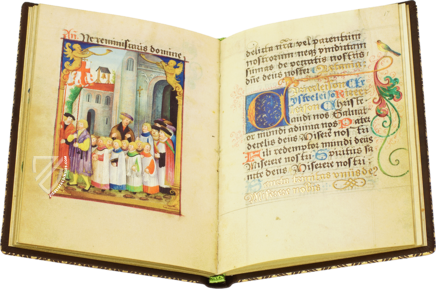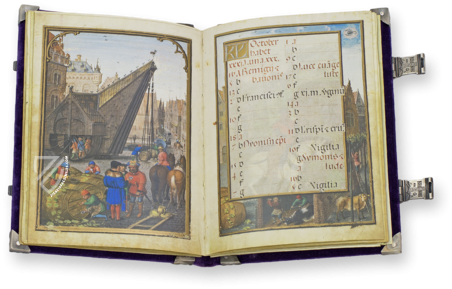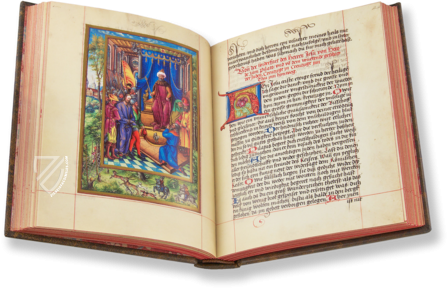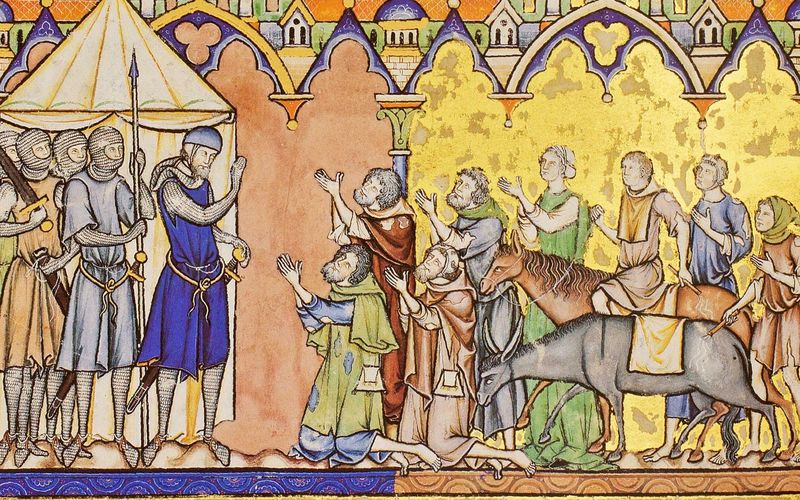Golden Calendar of Albrecht Glockendon from 1526
(under 1,000€)
Albrecht Glockendon the Elder was a member of a famous Nuremberg family of artists and miniaturists during the Dürer period. This small but splendid codex is evidence that in the 16th century, when manuscripts and thereby the art of illumination were being slowly replaced by printing, great artists were still active in this field and produced truly masterful specimens of book art. The illuminated calendar book has miniatures for each month that combine typical labors or activities with zodiac symbols as well as ornamental elements. These scenes from everyday life in the early 16th century are painted with the finest pigments and generously adorned with gold leaf. The masterfully written with text is also highlighted with gold ink and consists of poems describing the month and giving advice specific to it. The final section has tables for calculating the church calendar or when to perform medical procedures like bloodletting as well as a magnificent miniature of the so-called zodiac man.
Golden Calendar of Albrecht Glockendon from 1526
The Nuremberg miniaturist Albrecht Glockendon created a wonderful gem of 16th century illumination with his Golden Calendar of Albrecht Glockendon from 1526. His 16-page astrological text with an everlasting calendar assembles a wonderful miniature for each month and the small book concludes with astrological tables and references, e.g. for bloodletting or calculating church holidays during the year. Decorative miniatures with scenes from everyday life are adorned with zodiac signs as well as floral and ornamental elements in the most luminous colors and with the lavish application of gold leaf.
A Nuremberg Miniaturist of the Dürer Period
Albrecht Glockendon, the artist of this wonderful manuscript, originated from a famous Nuremberg family of artists and miniaturists during the Dürer period. He was employed by a diverse milieu of patrons both noble and common. With his highly-prized artistic works, Albrecht Glockendon provided evidence that in the 16th century, when manuscripts and thereby the art of illumination were being slowly replaced by printing, great artists were still active in this field and produced truly masterful performances.
Twelve Months in Twelve Wonderful Miniatures
The 32 pages of the Golden Calendar from 1526 demonstrates why the miniaturist from Nuremberg was so highly esteemed. Each double-page deals with one of the twelve months, whereby a miniature illustrating the accompanying text in poetic form is featured on the verso. The respective month is explained by its sign and suitable life rules in gorgeous script with countless decorative flourishes and sometimes even gold ink. The decorative and richly-detailed miniatures attest to the great artistry of Albrecht Glockendon at his best. As such, the illustration for March shows a wonderful scene of farmers with horse and cart during field work, June is accompanied by a depiction of sheep shearing, which comes due in this month. Three people dressed like farmers sit before a green landscape with half-timbered houses in the background, each holding a wooly sheep for sheering, respectively. Illustrations like this and others from the agricultural cycle of the year accentuate the manuscript’s everlasting calendar. The small pictures are framed by decorative architectural ornaments in gold, which stand before the depictions like theater scenery. There is a medallion of the respective zodiac sign in the decorative border under the illustration, which is surrounded by floral ornamentation. Everything is designed in the brightest of colors with the most loving detail.
Artfully Designed Astrological Tables and Tools
Following after the 12 months are four pages with astrological content, which expanded on the rules for life in the depiction of the months. An artfully-designed man being bled is given along with a table for determining the position of the moon for information on an advantageous date for a bloodletting. A compass helps with the calculation of specific dates and numbers relating to the agricultural calendar. Albrecht Glockendon’s calendar book represents an impressive example for the connection of traditional knowledge from the country with the new humanist interest in astrological phenomena. The illustrations are of high worth for art history, the entire calendar book offers collectors and enthusiasts the wonderful opportunity to immerse themselves in the miniature art of Albrecht Glockendon.
Codicology
- Alternative Titles
- Albrecht Glockendons goldener Kalender aus dem Jahre 1526
Kalendar von 1526
Albrecht Glockendons Prachtkalender vom Jahre 1526 - Size / Format
- 32 pages / 14.0 × 10.0 cm
- Origin
- Germany
- Date
- 1526
- Epochs
- Style
- Genre
- Language
- Illustrations
- 14 gilded calender miniatures
- Artist / School
- Albrecht Glockendon the Elder (before 1500–1545)
Golden Calendar of Albrecht Glockendon from 1526
Sowing Winter Rye
The artist indicates that the month depicted is October via two lions holding a pair of scales, the zodiac symbol for Libra. After the harvests of late summer, autumn was a time for preparing for winter and the coming spring. On the left we see a farmer sowing rye, which is able to germinate under the snow and provide an initial grain harvest in the spring. It also serves to keep out weeds and it can be tilled back into the soil to enrich it even if it is not harvested.
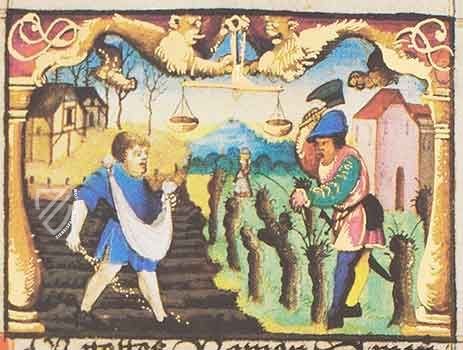
Golden Calendar of Albrecht Glockendon from 1526
Portrait of the Duke of Berry in Prayer
Labors of the month, zodiac signs, and poetic advice for farming and bloodletting are all combined in this everlasting calendar. Here we see the month of October, identifiable by the Scorpio sign flanked by two cherubs just below the miniature, wherein wine is being made, hence the name Weinlesemonat or “wine harvest month” in medieval German.
Like the rest of the manuscript, the page is richly adorned with luminous gold leaf, including a golden architecture framing the miniature. Occurring in an interior space, everyone in the scene is dressed in bright colors and appears to be excited about the wine harvest, from the man stomping the grapes on the left, to the two women on the right who are filling the wine barrel.
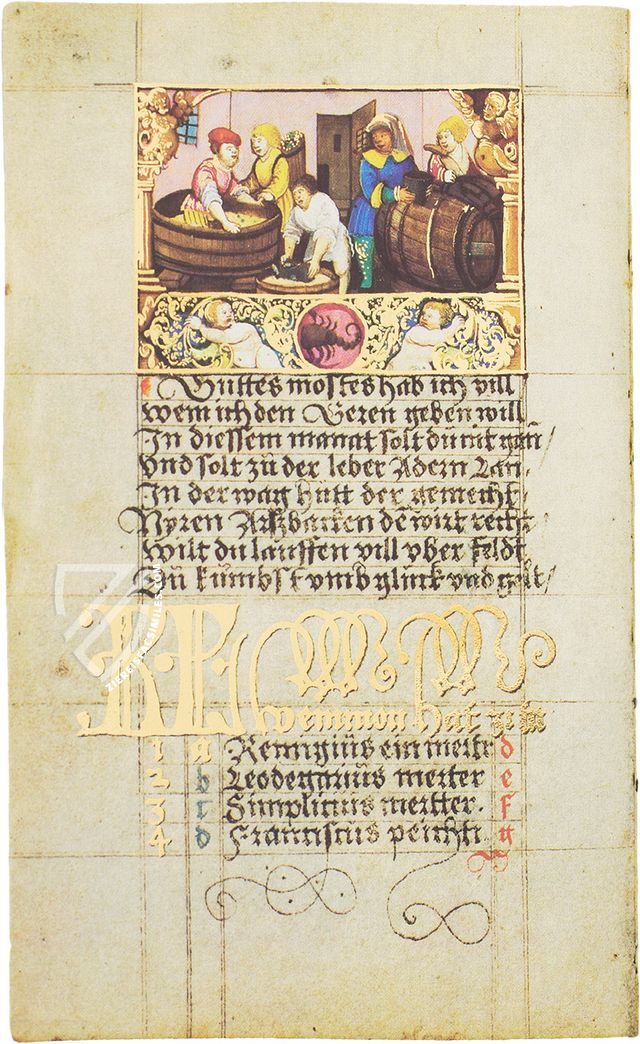
#1 Albrecht Glockendon Kalender von 1526
Language: German
(under 1,000€)
- Treatises / Secular Books
- Apocalypses / Beatus
- Astronomy / Astrology
- Bestiaries
- Bibles / Gospels
- Chronicles / History / Law
- Geography / Maps
- Saints' Lives
- Islam / Oriental
- Judaism / Hebrew
- Single Leaf Collections
- Leonardo da Vinci
- Literature / Poetry
- Liturgical Manuscripts
- Medicine / Botany / Alchemy
- Music
- Mythology / Prophecies
- Psalters
- Other Religious Books
- Games / Hunting
- Private Devotion Books
- Other Genres
- Afghanistan
- Armenia
- Austria
- Belgium
- Belize
- Bosnia and Herzegovina
- China
- Colombia
- Costa Rica
- Croatia
- Cyprus
- Czech Republic
- Denmark
- Egypt
- El Salvador
- Ethiopia
- France
- Germany
- Greece
- Guatemala
- Honduras
- Hungary
- India
- Iran
- Iraq
- Israel
- Italy
- Japan
- Jordan
- Kazakhstan
- Kyrgyzstan
- Lebanon
- Liechtenstein
- Luxembourg
- Mexico
- Morocco
- Netherlands
- Palestine
- Panama
- Peru
- Poland
- Portugal
- Romania
- Russia
- Serbia
- Spain
- Sri Lanka
- Sweden
- Switzerland
- Syria
- Tajikistan
- Turkey
- Turkmenistan
- Ukraine
- United Kingdom
- United States
- Uzbekistan
- Vatican City
- A. Oosthoek, van Holkema & Warendorf
- Aboca Museum
- Ajuntament de Valencia
- Akademie Verlag
- Akademische Druck- u. Verlagsanstalt (ADEVA)
- Aldo Ausilio Editore - Bottega d’Erasmo
- Alecto Historical Editions
- Alkuin Verlag
- Almqvist & Wiksell
- Amilcare Pizzi
- Andreas & Andreas Verlagsbuchhandlung
- Archa 90
- Archiv Verlag
- Archivi Edizioni
- Arnold Verlag
- ARS
- Ars Magna
- ArtCodex
- AyN Ediciones
- Azimuth Editions
- Badenia Verlag
- Bärenreiter-Verlag
- Belser Verlag
- Belser Verlag / WK Wertkontor
- Benziger Verlag
- Bernardinum Wydawnictwo
- BiblioGemma
- Biblioteca Apostolica Vaticana (Vaticanstadt, Vaticanstadt)
- Bibliotheca Palatina Faksimile Verlag
- Bibliotheca Rara
- Boydell & Brewer
- Bramante Edizioni
- Bredius Genootschap
- Brepols Publishers
- British Library
- C. Weckesser
- Caixa Catalunya
- Canesi
- CAPSA, Ars Scriptoria
- Caratzas Brothers, Publishers
- Carus Verlag
- Casamassima Libri
- Centrum Cartographie Verlag GmbH
- Chavane Verlag
- Christian Brandstätter Verlag
- Circulo Cientifico
- Club Bibliófilo Versol
- Club du Livre
- CM Editores
- Collegium Graphicum
- Collezione Apocrifa Da Vinci
- Comissão Nacional para as Comemorações dos Descobrimentos Portugueses
- Coron Verlag
- Corvina
- CTHS
- D. S. Brewer
- Damon
- De Agostini/UTET
- De Nederlandsche Boekhandel
- De Schutter
- Deuschle & Stemmle
- Deutscher Verlag für Kunstwissenschaft
- DIAMM
- Droz
- E. Schreiber Graphische Kunstanstalten
- Ediciones Boreal
- Ediciones Grial
- Ediclube
- Edições Inapa
- Edilan
- Editalia
- Edition Deuschle
- Edition Georg Popp
- Edition Leipzig
- Edition Libri Illustri
- Editiones Reales Sitios S. L.
- Éditions de l'Oiseau Lyre
- Editions Medicina Rara
- Editorial Casariego
- Editorial Mintzoa
- Editrice Antenore
- Editrice Velar
- Edizioni Edison
- Egeria, S.L.
- Eikon Editores
- Electa
- Emery Walker Limited
- Enciclopèdia Catalana
- Eos-Verlag
- Ephesus Publishing
- Ernst Battenberg
- Eugrammia Press
- Extraordinary Editions
- Fackelverlag
- Facsimila Art & Edition
- Facsimile Editions Ltd.
- Facsimilia Art & Edition Ebert KG
- Faksimile Verlag
- Feuermann Verlag
- Folger Shakespeare Library
- Franco Cosimo Panini Editore
- Friedrich Wittig Verlag
- Fundación Hullera Vasco-Leonesa
- G. Braziller
- Gabriele Mazzotta Editore
- Gebr. Mann Verlag
- Gesellschaft für graphische Industrie
- Getty Research Institute
- Giovanni Domenico de Rossi
- Giunti Editore
- Graffiti
- Grafica European Center of Fine Arts
- Guido Pressler
- Guillermo Blazquez
- Gustav Kiepenheuer
- H. N. Abrams
- Harrassowitz
- Harvard University Press
- Helikon
- Hendrickson Publishers
- Henning Oppermann
- Herder Verlag
- Hes & De Graaf Publishers
- Hoepli
- Holbein-Verlag
- Houghton Library
- Hugo Schmidt Verlag
- Idion Verlag
- Il Bulino, edizioni d'arte
- ILte
- Imago
- Insel Verlag
- Insel-Verlag Anton Kippenberger
- Instituto de Estudios Altoaragoneses
- Instituto Nacional de Antropología e Historia
- Istituto dell'Enciclopedia Italiana - Treccani
- Istituto Ellenico di Studi Bizantini e Postbizantini
- Istituto Geografico De Agostini
- Istituto Poligrafico e Zecca dello Stato
- Italarte Art Establishments
- Jan Thorbecke Verlag
- Johnson Reprint Corporation
- Josef Stocker
- Josef Stocker-Schmid
- Jugoslavija
- Karl W. Hiersemann
- Kasper Straube
- Kaydeda Ediciones
- Kindler Verlag / Coron Verlag
- Kodansha International Ltd.
- Konrad Kölbl Verlag
- Kurt Wolff Verlag
- La Liberia dello Stato
- La Linea Editrice
- La Meta Editore
- Lambert Schneider
- Landeskreditbank Baden-Württemberg
- Leo S. Olschki
- Les Incunables
- Liber Artis
- Library of Congress
- Libreria Musicale Italiana
- Lichtdruck
- Lito Immagine Editore
- Lumen Artis
- Lund Humphries
- M. Moleiro Editor
- Maison des Sciences de l'homme et de la société de Poitiers
- Manuscriptum
- Martinus Nijhoff
- Maruzen-Yushodo Co. Ltd.
- MASA
- Massada Publishers
- McGraw-Hill
- Metropolitan Museum of Art
- Militos
- Millennium Liber
- Müller & Schindler
- Nahar - Stavit
- Nahar and Steimatzky
- National Library of Wales
- Neri Pozza
- Nova Charta
- Oceanum Verlag
- Odeon
- Orbis Mediaevalis
- Orbis Pictus
- Österreichische Staatsdruckerei
- Oxford University Press
- Pageant Books
- Parzellers Buchverlag
- Patrimonio Ediciones
- Pattloch Verlag
- PIAF
- Pieper Verlag
- Plon-Nourrit et cie
- Poligrafiche Bolis
- Presses Universitaires de Strasbourg
- Prestel Verlag
- Princeton University Press
- Prisma Verlag
- Priuli & Verlucca, editori
- Pro Sport Verlag
- Propyläen Verlag
- Pytheas Books
- Quaternio Verlag Luzern
- Reales Sitios
- Recht-Verlag
- Reichert Verlag
- Reichsdruckerei
- Reprint Verlag
- Riehn & Reusch
- Roberto Vattori Editore
- Rosenkilde and Bagger
- Roxburghe Club
- Salerno Editrice
- Saltellus Press
- Sandoz
- Sarajevo Svjetlost
- Schöck ArtPrint Kft.
- Schulsinger Brothers
- Scolar Press
- Scrinium
- Scripta Maneant
- Scriptorium
- Shazar
- Siloé, arte y bibliofilia
- SISMEL - Edizioni del Galluzzo
- Sociedad Mexicana de Antropología
- Société des Bibliophiles & Iconophiles de Belgique
- Soncin Publishing
- Sorli Ediciones
- Stainer and Bell
- Studer
- Styria Verlag
- Sumptibus Pragopress
- Szegedi Tudomànyegyetem
- Taberna Libraria
- Tarshish Books
- Taschen
- Tempus Libri
- Testimonio Compañía Editorial
- Thames and Hudson
- The Clear Vue Publishing Partnership Limited
- The Facsimile Codex
- The Folio Society
- The Marquess of Normanby
- The Richard III and Yorkist History Trust
- Tip.Le.Co
- TouchArt
- TREC Publishing House
- TRI Publishing Co.
- Trident Editore
- Tuliba Collection
- Typis Regiae Officinae Polygraphicae
- Union Verlag Berlin
- Universidad de Granada
- University of California Press
- University of Chicago Press
- Urs Graf
- Vallecchi
- Van Wijnen
- VCH, Acta Humaniora
- VDI Verlag
- VEB Deutscher Verlag für Musik
- Verlag Anton Pustet / Andreas Verlag
- Verlag Bibliophile Drucke Josef Stocker
- Verlag der Münchner Drucke
- Verlag für Regionalgeschichte
- Verlag Styria
- Vicent Garcia Editores
- W. Turnowski Ltd.
- W. Turnowsky
- Waanders Printers
- Wiener Mechitharisten-Congregation (Wien, Österreich)
- Wissenschaftliche Buchgesellschaft
- Wissenschaftliche Verlagsgesellschaft
- Wydawnictwo Dolnoslaskie
- Xuntanza Editorial
- Zakład Narodowy
- Zollikofer AG

